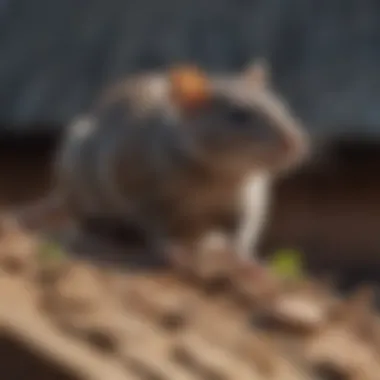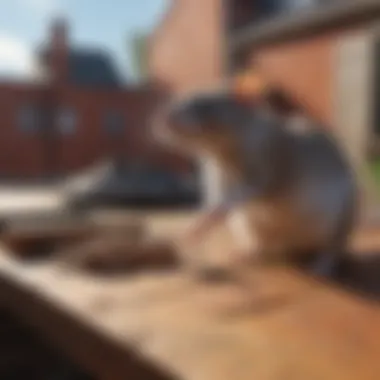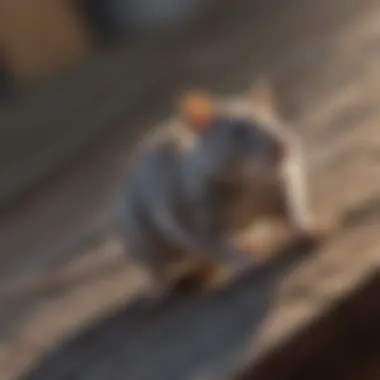A Comprehensive Guide to Trapping Roof Rats Effectively


Intro
Roof rats, often mistaken for other rodent species, pose significant challenges for households. They inhabit various regions but are especially problematic in urban areas where they find numerous food sources. Understanding these pests is crucial for effective control and prevention.
This article provides a thorough exploration of roof rats, focusing on their behaviors, life cycle, and suitable methods for trapping them. We will delve into pest prevention strategies and control methods vital for homeowners. The aim is to equip readers with the knowledge necessary to address potential infestations with confidence.
Understanding the Pest
Identification
Identifying roof rats is the first step towards effective control. These rodents are typically slender, with long tails and a pointed nose. Their fur is usually a mix of black and brown, and they can weigh between 5 to 10 ounces. Roof rats differ from Norway rats, which are bulkier and have shorter tails.
To confirm a roof rat infestation, look for certain signs:
- Gnaw marks on food packaging or furniture.
- Droppings, which are about half an inch long with pointed ends.
- Nesting materials, such as shredded paper or insulation.
Life Cycle
Understanding the life cycle of roof rats can aid in managing their populations.
These rats generally reproduce throughout the year, but peak breeding occurs in warmer months. A female can have up to 5 litters per year, with each litter containing 6 to 8 young. The young are born blind and hairless, but within a few weeks, they are ready to venture out for food. Understanding this rapid reproduction rate is crucial for effective pest management.
Pest Prevention Strategies
Preventing roof rats from entering your home is vital. Several strategies can mitigate the risks of infestations.
Environment Modification
By modifying the environment, homeowners can make their spaces less appealing to roof rats. Keep food sealed and stored properly. Remove clutter and debris that might provide shelter. Eliminate standing water sources, as roof rats are attracted to moist environments.
Physical Barriers
Installing physical barriers is another effective strategy. Here are some methods to consider:
- Seal entry points: Use caulk or steel wool to close gaps and holes in walls and foundations.
- Trim vegetation: Cut back trees and shrubs that are close to the home, as roof rats can easily climb.
- Secure garbage: Use rodent-proof bins to prevent access to food sources.
Control Methods
Once prevention measures are taken, controlling an existing roof rat population becomes the next focus.
Chemical Control
Chemical control involves the use of rodenticides. These should be used with caution, as they can pose risks to pets and children. Always follow label instructions and keep these products out of reach.
Biological Control
Biological control methods are less common but can be impactful. This includes the introduction of natural predators, such as cats or even certain birds of prey, to keep the roof rat numbers in check. However, this method should be carefully considered to avoid unintended consequences.
Effective pest control requires a balanced approach that includes prevention, identification, and control methods.
By employing these strategies, homeowners can significantly reduce the risk of roof rat infestations and protect their living spaces. Understanding the behavior and life cycle of these rodents empowers property owners to manage them efficiently.
Understanding Roof Rats
Understanding roof rats is essential for effectively managing and controlling their populations. These rodents are notorious for invading homes and other structures, leading to various problems. By grasping their characteristics and behaviors, homeowners can make informed decisions about trapping and prevention. This section outlines key elements of roof rats that will be beneficial for the reader.
Physical Characteristics
Size and Weight
Roof rats typically measure between 12 to 18 inches long, including the tail. Their weight can vary from 5 to 10 ounces. This relatively small size allows them to infiltrate tight spaces easily. The size contributes to their ability to access various areas in a home, making it crucial for homeowners to identify and trap them effectively.
Color and Fur Texture
The fur of roof rats is generally smooth and can range from black to grayish-brown. This color variation provides them with some camouflage. The distinct fur texture enhances their adaptability to different environments, allowing them to thrive in urban settings where they may encounter diverse conditions. Understanding their color helps in quick identification, leading to effective control strategies.


Distinctive Features
Roof rats possess long tails that are always longer than their bodies. This characteristic lets them balance well when climbing. Their large ears and sharp whiskers also play a significant role in their sensory perception. These distinctive features not only aid in their survival but also inform trapping techniques. Being aware of these attributes helps in crafting specific strategies for effective trapping.
Behavioral Traits
Social Structure
Roof rats exhibit social behaviors, often living in groups. This social structure can complicate trapping efforts as they tend to communicate effectively. Understanding their social dynamics is vital for target approaches. It allows homeowners to anticipate movements and plan the placement of traps accordingly.
Feeding Habits
Roof rats are omnivorous and have a diverse diet. They consume fruits, nuts, seeds, and even pet food. Their feeding habits can lead to significant food contamination in a home, highlighting the need for efficient trapping. Awareness of their preferences can aid in selecting bait that attracts them to traps.
Nocturnal Activity
These rats are primarily nocturnal, meaning they are most active at night. Their nocturnal nature adds complexity to trapping efforts since homeowners may not realize the extent of the infestation until evening hours. Understanding this behavior is essential for timing the placement of traps effectively.
Habitat and Nesting Preferences
Common Locations
Roof rats usually prefer elevated areas such as attics, ceilings, and trees. Identifying these common locations helps homeowners focus their trapping efforts. By targeting spots where rats are most likely to nest, effective control measures can be established.
Building Structures
In urban environments, roof rats commonly infest wooden structures, especially where insulation is prominent. This is important knowledge for homeowners, as understanding the types of buildings that attract these rodents can guide preventative actions. Taking steps to make these structures less appealing, such as managing insulation, is vital in controlling populations.
Nesting Materials
Roof rats often use materials like paper, cloth, and other soft items for nesting. Knowing the kinds of materials they prefer can help in disrupting their nesting habits. Additionally, destroying potential nesting sites can be an effective proactive measure against infestations.
Understanding roof rats is not just about knowledge; it is about empowering homeowners to take effective action against these pests.
The Importance of Trapping Roof Rats
Understanding the significance of trapping roof rats is crucial for both effective pest management and public health. Roof rats, known for their agility and intelligence, can cause numerous issues when they invade residential and commercial buildings. Addressing this problem through effective trapping is not only beneficial for immediate control but also essential for preventing long-term infestations. It is important for homeowners and pest control professionals alike to grasp the nuances of trapping techniques.
Risks Associated with Infestations
Health Hazards
Health risks posed by roof rat infestations are a major concern. These rodents can carry diseases such as leptospirosis and hantavirus, which can transmit to humans through direct contact or via contaminated surfaces. This characteristic makes understanding health hazards a clear advantage for anyone interested in pest control. Recognizing the danger roof rats present helps encourage prompt action.
In addition, the environment they inhabit can amplify these risks. Contaminated water sources and food supplies can lead to outbreaks, further emphasizing the need for control measures. Proper trapping significantly reduces the likelihood of these health hazards affecting households.
Property Damage
Roof rats are notorious for their gnawing behavior, which can lead to significant property damage. They canchew through electrical wiring, insulation, and structural materials. This unique feature of their behavior indicates a necessity for effective trapping. Damage not only incurs repair costs but can also lead to dangerous situations, such as electrical fires.
The implications of unchecked property damage highlight the importance of using trapping methods effectively. Reducing the population through trapping can help mitigate these costly repairs and also improve safety in a home environment.
Food Contamination
Food contamination is another critical risk associated with roof rats. These animals can contaminate food supplies, leading to potential health risks for families. Their droppings and urine can carry pathogens that spoil food and spread diseases. This consideration supports the argument for effective trapping as a method to safeguard food sources.
Ensuring kitchens and pantry areas remain free from contamination requires diligent trapping practices. By actively reducing the roof rat population, homeowners can protect their families from foodborne illnesses that may arise from such infestations.
Benefits of Effective Trapping
Immediate Control
One of the most significant benefits of trapping roof rats is immediate control of the population. Setting traps allows for on-the-spot removal of these pests, providing swift relief. This aspect of trapping is vital because it can prevent further invasion and damage almost instantly.
Homeowners can observe a noticeable reduction in activity once traps are properly set. Reducing the roof rat population promptly supports the ongoing safety and comfort in a living environment.
Long-Term Solutions


Effective trapping also serves as part of a broader long-term solution to roof rat infestations. By regularly monitoring and maintaining traps, homeowners can keep rat populations in check over time. This proactive approach enables households to avert future infestations and reduces reliance on chemicals and poisons.
The integration of trapping into comprehensive pest control strategies enhances effectiveness. Creating sustainable methods that include trapping is an intelligent choice for any practicing pest control professional or vigilant homeowner.
Cost-Effectiveness
Finally, trapping is often a cost-effective strategy in pest management. Compared to ongoing expenses associated with using chemicals or hiring exterminators, traps provide a more affordable alternative for many households. This feature is especially beneficial for homeowners looking to maintain a budget while ensuring their living environments are rat-free.
Utilizing simple traps can significantly reduce the need for more expensive eradication methods. This financial aspect makes trapping a widely popular choice among homeowners seeking practical solutions to pest control.
Preparing for Trapping
Preparing for trapping roof rats is a fundamental step that ensures the effectiveness of any pest management strategy. By taking the necessary preparatory measures, homeowners can accurately identify infestations, select suitable traps, and implement the appropriate trapping methods. This not only maximizes the chances of success but also minimizes the potential for further issues down the line. Understanding the signs of infestation is key. With this information, one can adopt a systematic approach to rat control.
Identifying Infestation Signs
Droppings and Urine
Droppings and urine are often the most telling signs of a roof rat infestation. Roof rat droppings are typically capsule-shaped, about half an inch long, and may vary in color. The presence of droppings is a clear indicator of where these rodents are active. Urine, while not as easily seen, can often leave a distinct smell, which can help in identifying the areas where the infestations occur. Identifying these signs enables homeowners to target their trapping efforts more effectively.
The sooner you recognize the signs of infestation, the easier it will be to control it.
Gnaw Marks
Gnaw marks are another significant sign of roof rats. These rodents have strong incisors that can chew through various materials, including wood and plastic. Homeowners should look for marks around food sources, shelves, and stored items. Recognizing gnaw marks is beneficial as it indicates both the presence of rats and their preferred pathways. This helps in setting traps in strategic locations, where they are more likely to be effective.
Noise and Movement
Nocturnal activity of roof rats often leads to noticeable sounds during the night. Scratching or scurrying noises in the walls or attics can signal an infestation. Recognizing these sounds can alert homeowners to take action before the problem escalates. This knowledge contributes significantly to early detection and allows for prompt preventive measures.
Select Appropriate Traps
Types of Traps
There are several types of traps available for roof rats, including snap traps, glue traps, and live traps. Each type has its specific mechanisms and methods of capturing rats. Snap traps are quick and effective, while glue traps are less humane. Live traps, while allowing for relocation, necessitate diligence in handling captured rats humanely. Understanding these types helps homeowners to select the most appropriate trapping method based on their needs and circumstances.
Choosing the Right Trap
Selecting the right trap is crucial for effective pest control. Homeowners should consider factors such as the location of the infestation, the severity of the problem, and their ethical stance on pest removal. For example, snap traps work well in enclosed spaces, while live traps may be more suitable for those seeking a humane solution. Choosing wisely will yield better trapping results and minimize potential failures.
Considerations for Eco-Friendly Options
In recent years, interest in eco-friendly pest control has grown. Many homeowners are concerned about the impact of traditional traps on the environment. Eco-friendly options may include non-toxic baits or humane traps designed to minimize distress for captured animals. While these options can be effective, careful consideration of their limitations and effectiveness is essential. Emphasizing sustainable practices resonates with many individuals and can lead to responsible pest management.
Implementing Trapping Techniques
Implementing effective trapping techniques is a crucial step in managing roof rat infestations. This section underscores the significance of not only setting traps but also understanding how to optimize their placement and maintenance. With a strategic approach to trapping, homeowners can increase their chances of successful rodent control. The benefits include quicker results and reduced risks of further infestations. Each component, from setting up traps to ongoing monitoring, plays an essential role in the overall trapping process.
Setting Up the Traps
Optimal Locations
Choosing optimal locations for placing traps is fundamental to effective roof rat management. These locations must align with the paths rats frequently travel. Common spots include near nesting areas, along walls, and close to food sources. The strategic placement ensures the traps are more likely to catch any rats moving through these areas. One key characteristic of optimal locations is their high visibility to the rats, which translates into a higher probability of capture.
However, while these spots offer strong potential for trapping success, it’s necessary to consider the safety of children and pets when placing traps in residential areas.
Positioning Guidelines
Positioning guidelines are essential in maximizing the efficiency of traps. Installing the traps at a low height, near the ground where rats usually travel, is usually advised. This proximity to the ground allows for better engagement of the traps with the target species, raising the chances of capture. Another aspect to consider is ensuring traps face walls, as rats prefer to run along these structures.
The unique feature of proper positioning is that it can create a more conducive environment for the rats to encounter the traps. However, incorrect positioning can lead to missed opportunities, which might prolong the infestation and create a greater challenge in achieving complete control.
Bait Selection
Bait selection is a pivotal element of trapping success. The bait should be something that attracts roof rats effectively. As rodents are known for their sensitive taste, using highly appealing bait, such as peanut butter or seeds, is often a good choice. Bait must be securely placed within the trap to ensure it is not easily removed without triggering the mechanism.
The distinct feature of proper bait selection lies in its ability to lure rats into the traps. However, it’s also essential to monitor the bait regularly, as spoiled bait can lead to the traps losing their effectiveness. The cost associated with purchasing bait should be weighed against its role in ensuring successful trapping efforts, which should assist in administering effective control measures.


Monitoring and Maintenance
Regular Check-Ins
Conducting regular check-ins is crucial after traps have been set. Frequent monitoring helps to timely identify and remove any captured rats, preventing odor build-up and further health risks. Checking traps every day allows homeowners to respond quickly to captures and maintain their efficiency.
The key characteristic of regular check-ins is that they create a consistent review process, ensuring that traps remain functional. The downside to infrequent checks is that it can lead to issues such as trapped rats succumbing over time, creating potential health hazards inside the home.
Trap Cleaning
Trap cleaning is an often overlooked aspect of ongoing maintenance. Maintaining cleanliness of traps ensures they remain effective and safe. Cleaning traps involves removing any debris or remnants from captured rats. This prevents contamination and the potential spread of disease by ensuring that traps are sanitized properly.
One unique aspect of trap cleaning is its role in prolonging the usability of the traps over time. However, homeowners must ensure that any cleaning agents used are safe and do not repel future catches. Inadequate cleaning practices could ultimately diminish the traps’ effectiveness, hindering the goal of reducing rat populations.
Handling Captured Rats
Handling captured rats requires caution to avoid potential health risks. Once a rat is trapped, it needs to be dealt with promptly and humanely. Using gloves is highly recommended when disposing of captured rats, as they can carry diseases. Proper disposal methods should be followed according to local regulations.
One key characteristic of handling captured rats is ensuring minimal stress to both the individual and the rat. Safe handling reinforces responsible pest management practices. However, ignoring this step can lead to unnecessary health hazards and may also distress any remaining rats, affecting their behavior and mobility around the property.
It is important to approach trapping and handling of rats with a mindset of responsibility and care. Ignoring health and safety practices can lead to larger issues down the line.
Preventative Measures
Preventative measures are critical in managing roof rat populations effectively. Taking steps to reduce the risk of infestation not only protects your property but also contributes to overall health safety. Understanding key aspects, benefits, and considerations regarding preventative actions is essential.
Sealing Entry Points
Common Entry Areas
Common entry areas for roof rats include holes, cracks, and gaps in structures. Roof rats can squeeze through very small spaces, sometimes as small as half an inch. This characteristic makes identifying and sealing these areas vital for preventing infestations. Most commonly, roofs, vents, and areas where utility lines enter buildings are frequent target points. Addressing these entryways minimizes the likelihood of an invasion.
Recommended Materials
When sealing entry points, the choice of materials is important. Steel wool, caulk, and metal flashing are often recommended. Their durability serves as an effective barrier against roof rats. Steel wool, in particular, is favored due to its resistance to gnawing. However, it can deteriorate when exposed to moisture. Metal flashing is long-lasting but requires precise installation.
Maintenance Practices
Regular maintenance practices help ensure that sealed entry points remain effective. This includes routine inspections of seals and barriers to catch any deterioration early on. Keeping areas tidy also aids in preventing new infestations. Leading edges of gardens and surfaces around the building should be observed often. Neglecting maintenance may lead to missed opportunities in rat prevention.
Environmental Modifications
Landscaping Adjustments
Making landscaping adjustments can greatly discourage roof rats from nesting nearby. Keeping plants trimmed and bushes away from structures signals to rats that the area is less hospitable. Mulching with wood chips rather than gravel also creates less favorable nesting conditions. However, the downside is the need for consistent yard care to keep these adjustments effective.
Proper Waste Management
Proper waste management is crucial to eliminate food sources for roof rats. Sealing trash bins and utilizing composting methods that do not attract pests are effective strategies. Regularly cleaning up debris and leftovers further aids in preventing infestations. The drawback, however, is that it may require more effort in maintaining cleanliness, especially in high-traffic areas.
Composting Practices
Implementing effective composting practices is necessary for minimizing rat attraction. Using enclosed compost bins can deter access to food scraps. It's important to avoid adding items that might attract rodents. However, creating an efficient composting system can be challenging and demands attention and commitment. Finding the right balance will allow organic waste to be safely decomposed while keeping rats at bay.
Finale
The conclusion section holds significant weight in this article, encapsulating the essential elements and offering a broader context for the reader. It serves as a synthesis of the information presented, emphasizing the importance of trapping roof rats effectively. Knowledge about roof rat behavior, suitable trapping methods, and preventative measures contribute to a comprehensive approach to pest control.
Summary of Key Points
In review, several key points emerge from this guide:
- Understanding Roof Rats: Recognizing the physical characteristics and behavioral traits of roof rats is pivotal in addressing infestations. Their social structure, feeding habits, and nocturnal behavior inform strategies for effective trapping.
- The Importance of Trapping: The implications of rodent infestations extend beyond mere nuisance; they pose health hazards, cause property damage, and contaminate food supplies. Therefore, effective trapping is crucial in mitigating these risks.
- Preparing for Trapping: Proper identification of infestation signs and selecting the right traps are foundational steps. Different types of traps are available, each with unique advantages.
- Implementing Techniques: The setup and monitoring of traps must adhere to optimal guidelines. Regular check-ins and maintenance ensure ongoing effectiveness.
- Preventative Measures: Sealing entry points and making environmental modifications can significantly reduce risks of infestations.
Encouragement for Individual Action
Taking proactive measures against roof rats is within the reach of every homeowner. It is essential to understand that successful pest control starts with individual responsibility. By being vigilant in identifying signs of infestations, utilizing the right traps, and maintaining a clean environment, you can protect your home.
Furthermore, sharing knowledge and experiences with neighbors or local communities fosters a collective effort. This would not only help improve individual outcomes but also enhance community resilience against pest-related concerns. Remember, each small action contributes to a larger goal of maintaining a pest-free environment. Through informed choices and consistent actions, significant progress can be made.
"Awareness and preparation are your best allies in the fight against roof rats."
Implementing these strategies will lead to a healthier, safer home. Engage actively and encourage others to do the same for a pest-free living space.







